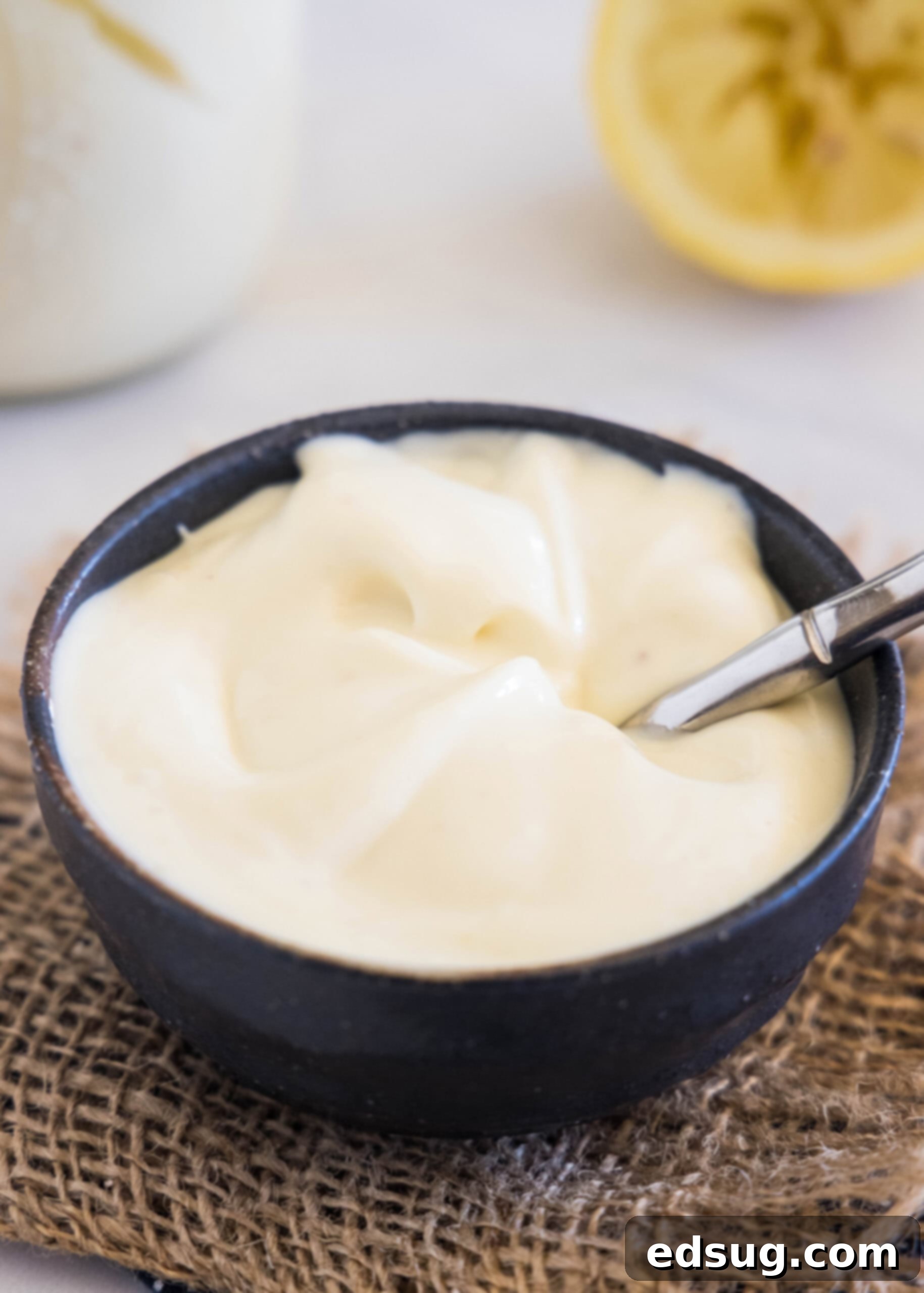Fail-Proof Homemade Mayo: The Easiest 10-Minute Immersion Blender Recipe for Creamy Perfection
Are you ready for a culinary revelation that will forever change your relationship with condiments? This incredibly simple, fail-proof homemade mayo recipe is about to become your new kitchen staple. Forget bland, store-bought jars; with just a handful of everyday ingredients and less than 10 minutes of your time, you can create rich, velvety mayonnaise from scratch that’s bursting with fresh flavor. Once you experience the superior taste and texture of homemade, you’ll wonder why you ever settled for anything less.
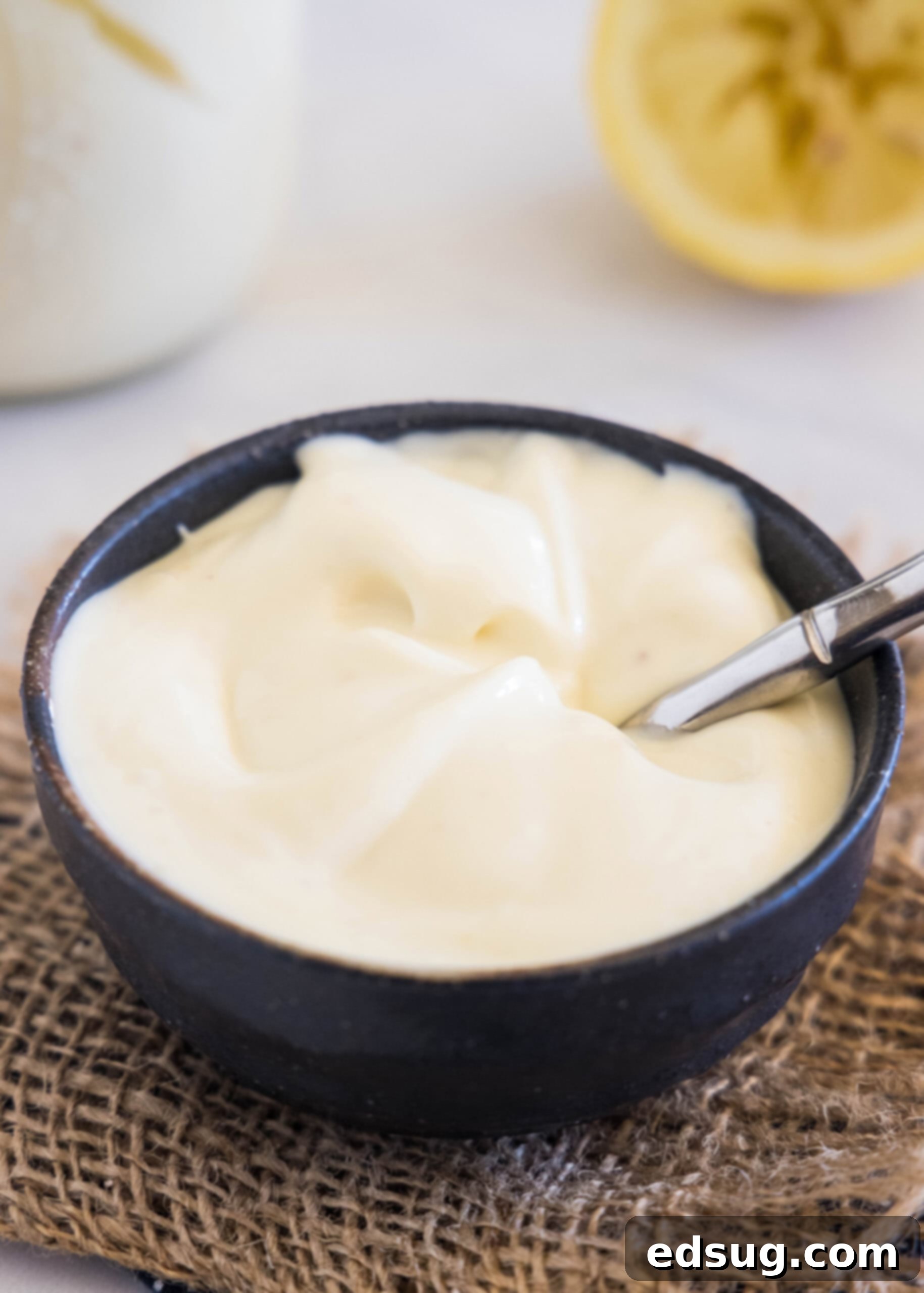
For years, many of us have relied on commercially produced mayonnaise, often overlooking the simple pleasure of making it ourselves. But I’m here to tell you that homemade mayonnaise is a game-changer. It’s not just “better”; it’s a completely different league of creamy, flavorful deliciousness. Made effortlessly with an immersion blender, this recipe ensures a perfectly emulsified, stable, and utterly delectable mayo every single time. Elevate your salads, transform your dressings, enhance your dips, or simply spread it generously on your favorite sandwich – homemade mayo truly does everything store-bought can, but with unparalleled freshness and taste.
Why Homemade Mayonnaise is a Must-Try
There are countless reasons to swap your store-bought mayo for this homemade version. Here are a few compelling benefits:
- Unbeatable Freshness & Flavor: The most significant advantage of homemade mayonnaise is its incredibly fresh taste. Free from industrial additives and preservatives, you get a clean, vibrant flavor that perfectly complements any dish.
- Fail-Proof Simplicity: This recipe utilizes a whole egg, which simplifies the process by eliminating the need to separate yolks and whites. The whole egg method also contributes to a more stable emulsion, significantly reducing the chances of your mayo breaking. It’s perfect for beginners!
- Control Over Ingredients: You know exactly what goes into your mayo. You can choose high-quality oils, organic eggs, and adjust seasonings to your preference, avoiding unwanted additives, sugars, or unhealthy oils found in many commercial brands.
- Easy & Accessible Ingredients: Chances are, you already have all the necessary components for this mayonnaise recipe in your pantry and fridge. It calls for common items, making it an accessible and budget-friendly condiment.
- Lightning-Fast Preparation: From start to finish, you can whip up a batch of creamy homemade mayo in just 5-10 minutes. It’s so quick that you can make it fresh whenever the craving strikes!
- Endless Customization: This basic recipe is a fantastic canvas for flavor experimentation. You can easily infuse it with herbs, spices, or other ingredients to create bespoke aiolis and flavored mayos tailored to your meals. We’ll explore some exciting variations later on.

Essential Ingredients for Your Homemade Mayonnaise
Making delicious homemade mayonnaise requires only a few fundamental ingredients. Each plays a crucial role in achieving that perfect creamy consistency and balanced flavor profile. You likely have most, if not all, of these in your kitchen right now!
For detailed measurements and step-by-step instructions, please scroll down to the printable recipe card.
- Egg: This recipe calls for one whole, raw large egg. The egg is the foundation of the emulsion, providing protein and lecithin that binds the oil and acid together. While the risk is low, if you’re concerned about consuming raw eggs, I highly recommend using pasteurized eggs. These eggs have been gently heated to eliminate bacteria like Salmonella, offering peace of mind without altering the recipe’s outcome. You’ll find them alongside regular eggs in most grocery stores.
- Dijon Mustard: More than just a flavor enhancer, Dijon mustard is a powerful emulsifier thanks to its mucilage content. It acts as a crucial safeguard, helping to prevent the mayonnaise from breaking and ensuring a stable, creamy texture. While Dijon is preferred for its balanced flavor, regular yellow mustard can be used in a pinch. You can make mayo without mustard, but it significantly increases the risk of your emulsion failing.
- Lemon Juice (or Vinegar): The acidity from fresh lemon juice is vital for both flavor and stability. It brightens the taste of the mayonnaise and helps the emulsion come together. White wine vinegar or apple cider vinegar are excellent alternatives if lemon juice isn’t available.
- Garlic: A single clove of freshly minced garlic adds a wonderful depth and subtle piquancy, transforming your mayo into a light aioli. However, if you’re not a fan of garlic or prefer a plain mayo, feel free to omit it. A ¼ teaspoon of garlic powder can also be used as a convenient substitute.
- Neutral Oil: The type of oil you choose heavily influences the flavor of your homemade mayonnaise. For a classic, mild-tasting mayo, a refined, neutral-flavored oil is best. My top recommendation is avocado oil due to its light flavor and high smoke point. Other excellent choices include canola oil, sunflower oil, grapeseed oil, or light olive oil. Avoid strong, unrefined oils like extra virgin olive oil, as their robust, sometimes peppery taste can be overpowering and clash with the delicate flavors of the mayonnaise. If you wish to incorporate olive oil, consider blending it with a mild oil or using a light, fruity olive oil for a subtle touch.
- Salt: A touch of salt is essential to enhance all the flavors in your mayonnaise. Adjust to taste once your mayo is fully emulsified.
How to Make Homemade Mayonnaise: The Immersion Blender Method
When it comes to crafting mayonnaise from scratch, the immersion blender (also known as a stick blender) reigns supreme as the easiest and most efficient tool. Its design allows for quick and effective emulsification, often in under a minute! A food processor with a small bowl attachment can also work, though it might require a slightly different technique. While it’s possible to make mayonnaise by hand with a whisk, be prepared for a vigorous workout and tired arms!
My preferred method, and the one detailed here, uses an immersion blender for its speed and simplicity. The printable instructions are available in the recipe card below, but here’s an overview of just how incredibly easy it is:
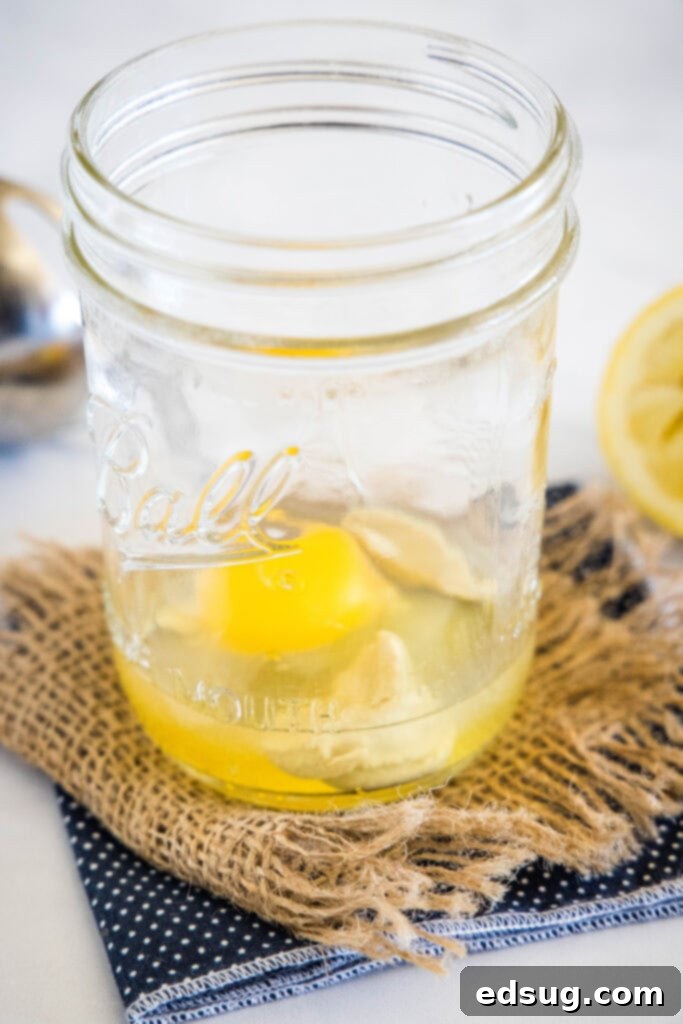

- Step 1: Combine the Base Ingredients. Start by adding the whole egg, lemon juice, Dijon mustard, minced garlic, and salt into a wide-mouth jar or a tall, narrow glass. Ensure your vessel is just wide enough for your immersion blender head to fit snugly, and tall enough so the ingredients cover the blades. This is crucial for successful emulsification.
- Step 2: Add the Oil. Carefully pour the neutral oil directly over the other ingredients. Do not stir. Let the mixture sit undisturbed for about 30-60 seconds. This brief resting period allows the egg and other ingredients to settle at the bottom, creating distinct layers that are ideal for the immersion blending technique.
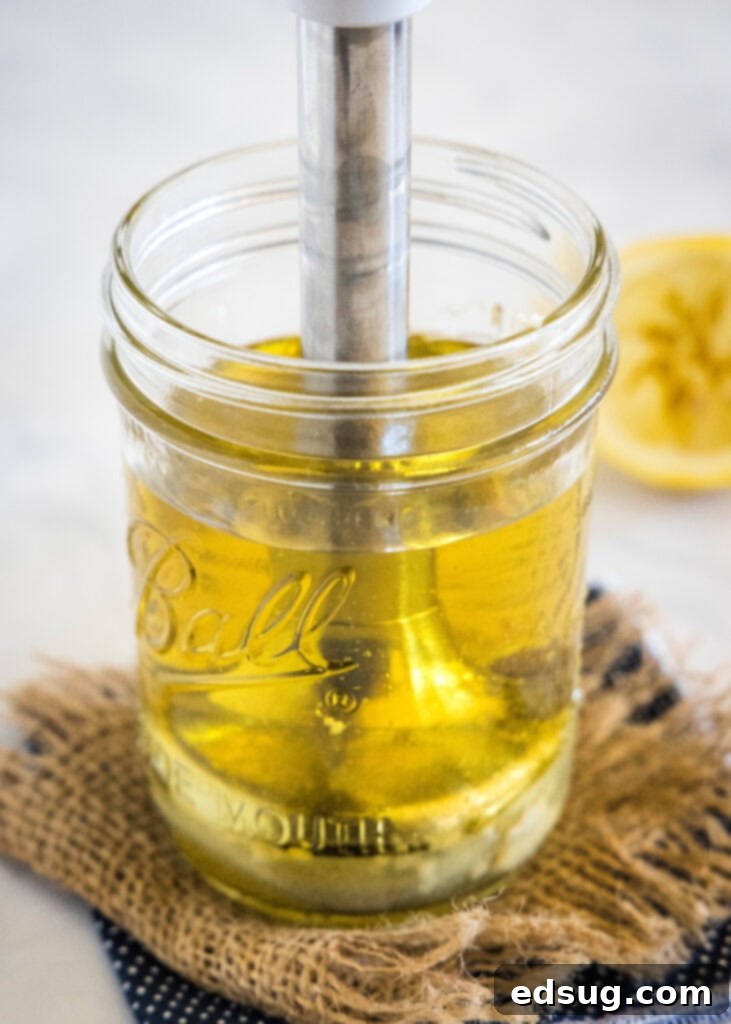
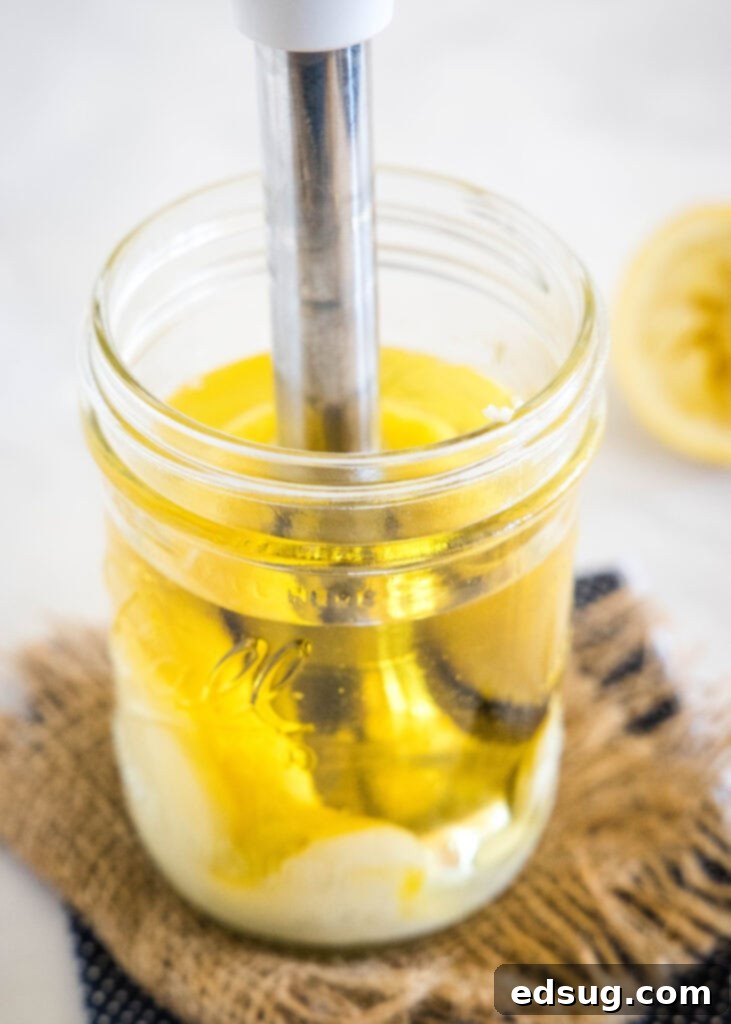
- Step 3: Blend to Emulsify. Insert your immersion blender into the bottom of the jar, making sure it’s completely submerged around the egg. Turn the blender on high and hold it steady at the bottom for about 15-20 seconds. You’ll notice the mixture at the bottom rapidly transforming into a thick, white, creamy mayonnaise.
- Step 4: Lift and Incorporate. As the bottom emulsifies, slowly and gradually tilt the blender wand slightly and begin to lift it upwards, allowing the oil from the top to be drawn into the blades and incorporated into the creamy base. Continue moving the blender up and down gently until all the oil is fully emulsified and the mixture is consistently thick and creamy. This process usually takes about 30-60 seconds in total.
- Step 5: Season and Store. Once your mayonnaise is beautifully thick and creamy (how easy was that?!), taste it and adjust the seasoning with more salt or lemon juice if desired. Transfer your fresh homemade mayo to an airtight container, cover, and store it in the refrigerator. Get ready to enjoy!

Expert Tips for Your Best Homemade Mayonnaise
While this recipe is designed to be fail-proof, a few key tips can ensure absolute success every time you make homemade mayo:
- Choose the Right Container: The dimensions of your blending vessel are critical. Use a jar or glass that is just wide enough for your immersion blender head to fit snugly, but narrow enough that the initial ingredients (egg, mustard, lemon juice) fully cover the blender blades at the bottom. If the liquid ingredients don’t reach the blades, the emulsion won’t start properly. If your container is too wide, or your ingredients are too sparse, simply double the recipe to ensure sufficient volume.
- Room Temperature Ingredients are Key: This is a golden rule for emulsions! Mayonnaise emulsifies most effectively when all ingredients are at a similar, warmer temperature. Cold ingredients can cause the oil to seize and the emulsion to break. Take your egg out of the fridge at least 30 minutes to an hour before you plan to make the mayo. If you’re short on time, you can quickly bring a cold egg to room temperature by submerging it in a bowl of lukewarm (not hot) water for a few minutes.
- Don’t Rush the Lift: When blending, resist the urge to immediately lift the immersion blender once the bottom starts to emulsify. Hold it steady for those initial 15-20 seconds to establish a strong emulsion base. Then, lift very slowly to gradually incorporate the remaining oil.
- Quality Ingredients Matter: Since there are so few ingredients, the quality of each really shines through. Use fresh eggs, good quality Dijon mustard, and the best neutral oil you can find for the most delicious results.
- Taste and Adjust: Always taste your mayonnaise before storing. You might find it benefits from an extra pinch of salt or a splash more lemon juice to perfectly balance the flavors.
Exciting Homemade Mayonnaise Variations
While the classic homemade mayonnaise is a pure delight, its simple base makes it incredibly versatile for flavor customization. Get creative and transform your mayo into a variety of delicious condiments:
- Garlic Aioli: The simplest variation! If you included garlic in the base recipe, you already have a fantastic homemade aioli. For an even deeper flavor, try making homemade garlic aioli with roasted garlic. The sweet, mellow notes of roasted garlic are exceptional.
- Herb Mayonnaise: Stir in 1-2 tablespoons of finely chopped fresh herbs like chives, dill, parsley, tarragon, or a mix of rosemary and thyme leaves. This adds a beautiful fresh aroma and vibrant color.
- Spicy Mayonnaise: Add a kick! Mix in 1-2 teaspoons of your favorite hot sauce (like Sriracha, Tabasco, or chipotle in adobo), a pinch of cayenne pepper, or a dash of red pepper flakes. For a bold, savory heat, try our spicy Cajun dipping sauce variation.
- Curry Mayonnaise: Infuse your mayo with exotic spices by blending in 1-2 teaspoons of curry powder. This is fantastic with chicken, roasted vegetables, or as a sandwich spread.
- Lemon-Herb Mayo: Combine fresh lemon zest with finely chopped dill and parsley for a bright, zesty, and herbaceous mayo perfect for seafood.
- Smoked Paprika Mayonnaise: Add a smoky depth with 1 teaspoon of smoked paprika. Great for burgers, fries, or grilled meats.

How to Rescue Broken Mayonnaise
Even with a fail-proof recipe, sometimes kitchen mishaps happen. If you’ve blended your mayonnaise and it looks curdled, separated, or thin instead of gloriously creamy, don’t despair! This is known as “broken mayo,” and it’s almost always fixable. This particular recipe, using a whole egg and the emulsifying power of mustard, is designed to be highly stable, but if yours does break, here are two effective methods to bring it back to life:
- Method 1: The Mustard Re-Emulsion.
- In a clean, separate bowl, place about 1 teaspoon of fresh Dijon mustard (or any strong mustard).
- Very gradually, add the broken mayonnaise to the mustard, a tiny amount at a time (start with ½ teaspoon), whisking vigorously with a fork or small whisk after each addition.
- The mustard will help to re-emulsify the mixture, binding the oil and egg together again. Continue slowly adding the broken mayo, whisking until the mixture becomes smooth and creamy once more. This method works because the mustard provides new emulsifying agents to stabilize the separated fat and water.
- Method 2: The Egg Yolk Recovery.
- Crack a fresh egg and carefully separate the yolk into a clean bowl, discarding the white.
- Using a fork or whisk, slowly drizzle the broken mayonnaise into the fresh egg yolk, whisking constantly and vigorously. Start with just a few drops, gradually increasing the amount as the emulsion begins to form.
- The lecithin in the fresh egg yolk acts as a powerful emulsifier, binding the separated oil and water particles from your broken mayo. Keep whisking until the desired creamy consistency is achieved.
Remember, patience is key when fixing broken mayonnaise. Add the broken mixture very slowly and whisk thoroughly after each addition to ensure proper re-emulsification.
Frequently Asked Questions About Homemade Mayonnaise
Is it safe to use raw eggs in homemade mayo?
Eggs are an indispensable ingredient for making traditional mayonnaise. The vast majority of commercially available eggs carry a low risk of Salmonella contamination. However, if you are pregnant, elderly, immunocompromised, or simply prefer to be extra cautious, it’s highly recommended to use pasteurized eggs. These eggs have been heat-treated to eliminate potential bacteria without cooking them. Always use fresh, refrigerated eggs, and avoid any eggs that appear dirty, cracked, or damaged. For more comprehensive guidance on egg safety, consult resources from health organizations like the CDC.
Can I use olive oil to make mayonnaise?
Yes, you absolutely can use olive oil to make mayonnaise, but with a crucial consideration: the flavor profile. Extra virgin olive oil, especially robust varieties, has a distinct and often peppery taste that can be quite overpowering in mayonnaise. This can result in a mayo that tastes bitter or too “grassy.” If you wish to use olive oil, I recommend one of two approaches: either use a light, fruitier olive oil with a milder taste, or blend it. A common technique is to replace only half of the neutral-flavored oil (like avocado or grapeseed) with your chosen olive oil to achieve a more balanced flavor that hints at olive oil without being overwhelming.
How do you thicken homemade mayonnaise?
If your homemade mayonnaise turns out runny or fails to thicken, it usually means the emulsion hasn’t fully formed or has broken. The most common reasons include cold ingredients, adding oil too quickly (if whisking by hand), or an issue with the blending process. Thankfully, it’s often salvageable! Refer to the “How to Rescue Broken Mayonnaise” section above for detailed steps on how to fix a thin or separated batch using either fresh mustard or an egg yolk. These methods are highly effective in thickening runny mayo.
How long does homemade mayonnaise last?
The shelf life of homemade mayonnaise is directly tied to the freshness of the eggs used. When properly stored in a tightly sealed container in the refrigerator, this homemade mayo typically lasts for up to 1 to 2 weeks. Always use the freshest possible eggs to maximize its longevity. As a general rule, if your eggs have an expiry date, your homemade mayo should be consumed within that timeframe, or ideally, within a week or two of making it fresh. Trust your senses: if it smells off, looks discolored, or tastes unusual, it’s best to discard it.

Delicious Ways to Use Your Fresh Homemade Mayonnaise
Once you’ve experienced the luxurious texture and vibrant flavor of fresh homemade mayo, you’ll find endless opportunities to incorporate it into your cooking. Beyond simply spreading it on a classic turkey club sandwich or a juicy crispy chicken sandwich, here are some fantastic ideas to elevate your meals:
- Elevate Your Salads: Homemade mayonnaise truly transforms classic dishes like egg salad, potato salad, and coleslaw, imparting a richer, fresher taste. It’s also superb in protein-packed options like Southwest chicken salad or tuna salad.
- Transform into Dressings: Use your homemade mayo as the creamy base for an array of delightful salad dressings. Whisk it into homemade ranch dressing, a flavorful Thousand Island dressing, or a vibrant avocado dressing to drizzle over greens, grilled chicken, or tacos.
- Indulge in Creamy Dips: From casual gatherings to game day feasts, homemade mayo is the secret ingredient for outstanding dips. It adds incredible richness to savory recipes like hot crab dip or the crowd-pleasing Reuben dip. You can also mix it with fresh herbs and spices for a simple veggie dip.
- Binder for Savory Cakes and Puffs: Mayonnaise acts as an excellent binder and flavor enhancer in savory cakes and patties. Try it in recipes like crispy shrimp cakes, tender homemade crab puffs, or even salmon patties.
- Gourmet Sandwich Spreads: Elevate any sandwich or burger. Mix with sriracha for spicy mayo, or add chopped pickles and capers for a quick tartare sauce.
- Roasted Vegetables: Toss vegetables like asparagus or Brussels sprouts with a spoonful of mayo before roasting for extra crispiness and flavor.
Storing Your Homemade Mayonnaise
To keep your homemade mayonnaise fresh and delicious, transfer it to a clean, airtight container (a mason jar works perfectly) immediately after blending. Store it in the coldest part of your refrigerator. As mentioned, its shelf life is typically 1 to 2 weeks, depending heavily on the freshness of your eggs. Always ensure the lid is tightly sealed to prevent oxidation and absorption of other refrigerator odors. If you notice any unusual smells, discoloration, or mold, it’s safest to discard the batch.
Can You Freeze Homemade Mayonnaise?
Unfortunately, freezing mayonnaise is not recommended. Mayonnaise is a delicate emulsion, a stable mixture of oil and water that wouldn’t normally combine. The freezing and thawing process causes the water particles to expand and then contract, breaking this fragile emulsion. The result is usually a separated, oily, and curdled mess with a watery, unappealing texture that cannot be easily revived. For the best quality and consistency, it’s always better to make a fresh batch whenever possible. Given how quickly and easily this recipe comes together, making it fresh is a breeze!
Discover More Homemade Condiments and Sauces
If you’ve enjoyed the process and flavor of making your own mayonnaise, you might be inspired to explore other homemade staples. Crafting your own condiments and sauces not only enhances the flavor of your meals but also gives you complete control over the ingredients. Here are some other fantastic recipes to try:
- Homemade Enchilada Sauce
- Homemade Buttermilk
- Easy Homemade Gravy
- Creamy Balsamic Vinaigrette
- Bread Dipping Oil
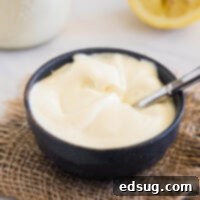
Homemade Mayo
Erin Sellin
5 minutes
5 minutes
1
cup (approx. eight 2 Tablespoon servings)
Pin Recipe
Rate Recipe
Print Recipe
Ingredients
-
1
whole large egg -
1
Tablespoon
Dijon mustard -
1
Tablespoon
lemon juice -
1
clove
garlic,
minced -
1
cup
avocado oil,
or other neutral oil -
½
teaspoon
salt
Instructions
-
Using a large mouth jar or glass (you want something that the immersion blender can just fit into) add the egg, lemon juice and mustard. Test that putting the immersion blender in the ingredients come up to the blades (this will ensure it fully emulsifies).1 whole large egg,
1 Tablespoon lemon juice,
1 Tablespoon Dijon mustard -
Remove the blender, add the garlic, salt and pour in the oil. Let the mixture set for 1 minute to slightly combine before blending. Add your immersion blender, and process on high. Once the mixture starts to emulsify, gently tilt the blender to the side and slowly rise to the top to fully blend everything together. This process should take about 1 minute.1 clove garlic,
1 cup avocado oil,
½ teaspoon salt -
Cover and store in the fridge for up to 2 weeks.
Notes
- Don’t have an immersion blender? Use a small food processor or a food processor that has a small bowl insert. If the egg, lemon juice, and mustard do not reach the blades before adding the oil, double the recipe.
Nutrition
Serving:
1
g
|
Calories:
252
kcal
|
Protein:
1
g
|
Fat:
28
g
|
Saturated Fat:
3
g
|
Polyunsaturated Fat:
23
g
|
Cholesterol:
23
mg
|
Sodium:
163
mg
Nutrition information is automatically calculated, so should only be used as an approximation.
Additional Info
Erin Sellin
5 minutes
5 minutes
The Basics
American
1
cup (approx. eight 2 Tablespoon servings)
252
homemade mayo, homemade mayonnaise
Love this recipe? Leave a comment and a star rating below!
Join our vibrant community on Facebook! It’s a fantastic space where you can share your favorite recipes, ask cooking questions, and stay updated on all the new delicious creations from Dinners, Dishes and Desserts. Don’t miss out on any new recipe discoveries!
Be sure to follow me on Instagram and
tag #dinnersdishes so I can see all the wonderful DINNERS, DISHES, AND DESSERTS
recipes YOU make!
Connect with me on social media and never miss a delicious post!
Facebook | Twitter | Pinterest | Instagram
.
